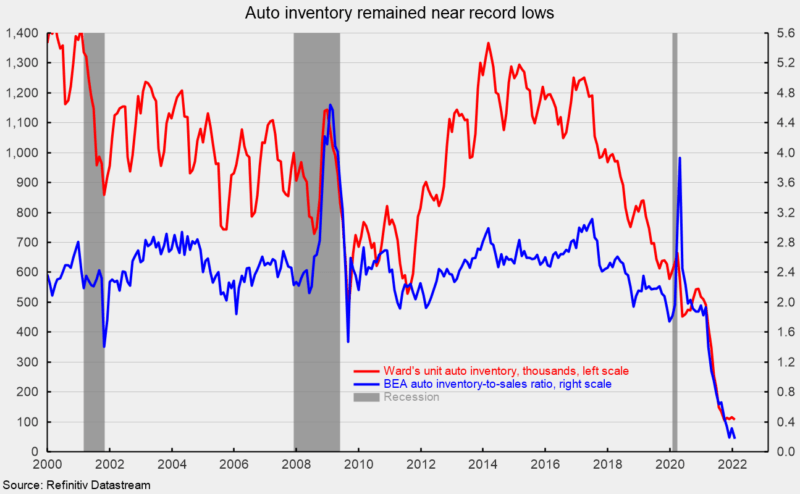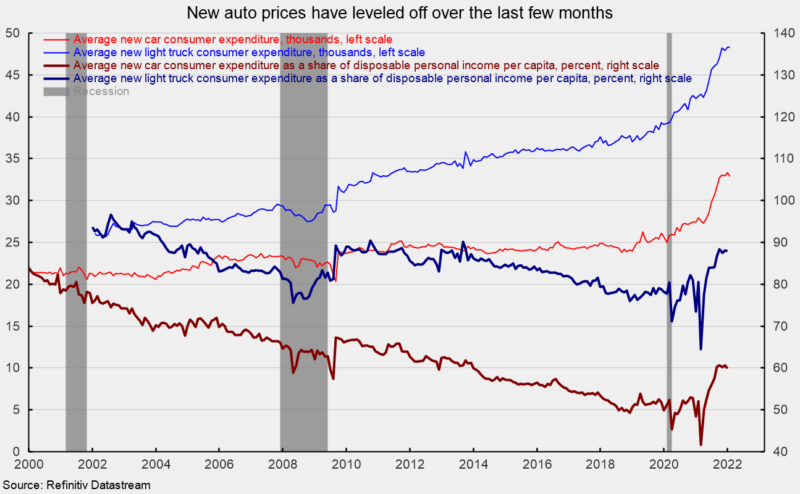Sales of light vehicles totaled 14.1 million at an annual rate in February, down from a 15.0 million pace in January. The February result was a 6.4 percent fall from the prior month and was the ninth consecutive month below the 16 to 18 million range, averaging just 13.7 million (see first chart). Weak auto sales are largely a result of component shortages that have limited production, resulting in plunging inventory and surging prices.
Breaking down sales by origin of assembly, sales of domestic vehicles decreased to 11.2 million units versus 12.0 million in January, a drop of 7.6 percent, while imports rose to 3.21 million versus 3.28 million in January, a decline of 2.1 percent. Domestic sales had generally been in the 13 million to 14 million range in the period before the pandemic, averaging 13.3 million for the six years through December 2019. The domestic share came in at 77.2 percent in February versus 78.2 in January. Domestic assemblies decreased slightly in January, coming in at 9.35 million at a seasonally adjusted annual rate. That is down from 9.47 million in December and still well below the 11.2 million pace for the six years through December 2019 (see first chart).
Component shortages, especially of computer chips, continue to restrain production for most manufacturers, creating a scarcity for many models, leading to lower inventory and higher prices. Ward’s estimate of unit auto inventory came in at 106,700 in January, near the all-time low (see second chart). Inventory may be stabilizing as the average over the last five months was 110,060 and has not dropped below 100,000. The Bureau of Economic Analysis estimates the inventory-to-sales ratio fell to 0.171 in January, a new record low, just slightly below the previous record low of 0.188 in November 2021 (see second chart).
The plunging inventory levels have pushed prices sharply higher over the last two years. However, prices may be stabilizing with the average consumer expenditure for a car coming in at $32,926 in January, down 1.1 percent from December. The average consumer expenditure on a light truck fell to $48,312 from $48,332 in December (see third chart). The January levels represent 12-month gains of 17.7 percent and 13.7 percent, respectively.
As a share of disposable personal income per capita, average consumer expenditures on a car came in at 59.9 percent versus 60.7 in December but just 41.6 percent in March 2021 while the average consumer expenditure on a light truck as a share of disposable personal income per capita was 87.9 percent versus 88.1 percent in December and 64.5 percent as recently as March 2021 (see third chart). Both measures are still below their all-time highs.
* This article was originally published here
PUBLISH WITH US!
The Washington Gazette works at our discretion with businesses, non-profits, and other organizations. We do not work with socialists, crony capitalists, or disinformation groups. Click the green button below to view our services!
HELP STOP THE SPREAD OF FAKE NEWS!
SHARE our articles and like our Facebook page and follow us on Twitter!









0 Comments